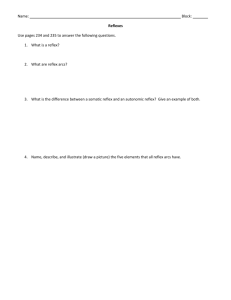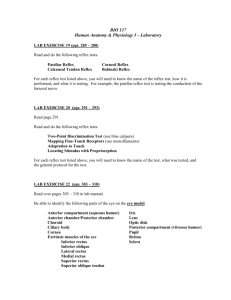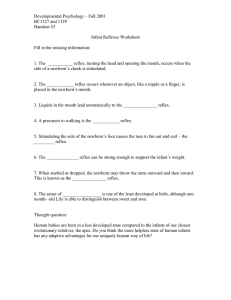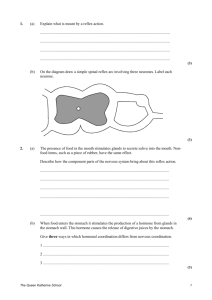Lab Exercise 10
advertisement
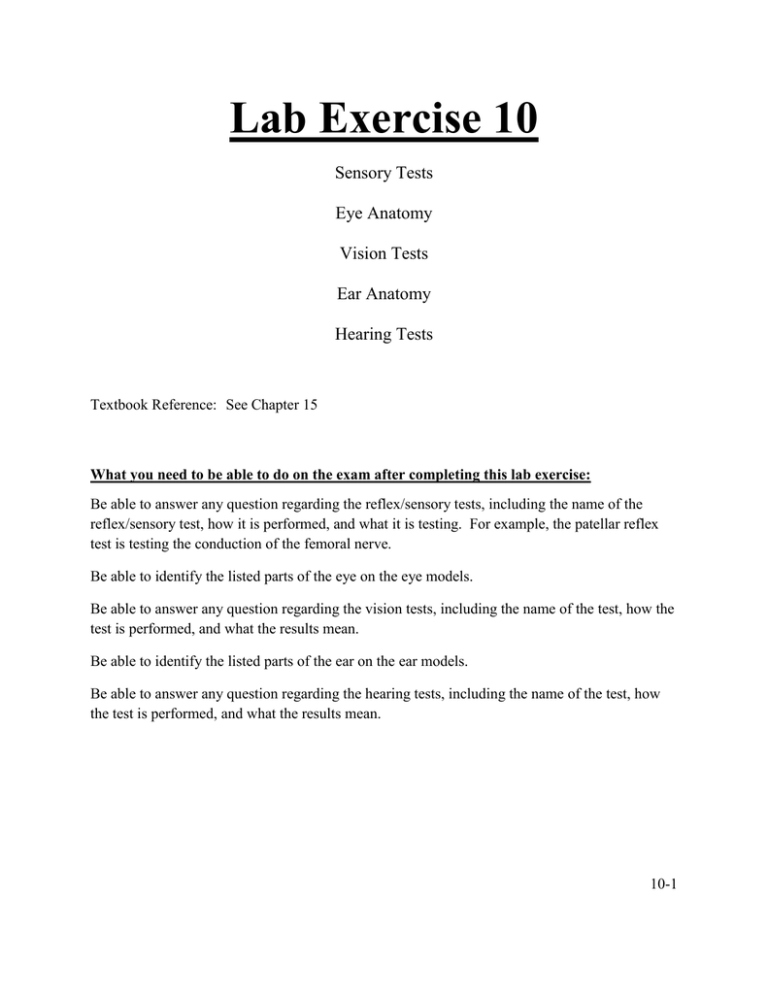
Lab Exercise 10 Sensory Tests Eye Anatomy Vision Tests Ear Anatomy Hearing Tests Textbook Reference: See Chapter 15 What you need to be able to do on the exam after completing this lab exercise: Be able to answer any question regarding the reflex/sensory tests, including the name of the reflex/sensory test, how it is performed, and what it is testing. For example, the patellar reflex test is testing the conduction of the femoral nerve. Be able to identify the listed parts of the eye on the eye models. Be able to answer any question regarding the vision tests, including the name of the test, how the test is performed, and what the results mean. Be able to identify the listed parts of the ear on the ear models. Be able to answer any question regarding the hearing tests, including the name of the test, how the test is performed, and what the results mean. 10-1 Sensory Tests Reflexes are involuntary, instantaneous movements in response to stimuli. Reflexes are mediated via a reflex arc, which includes a receptor, sensory neuron, integration center, motor neuron, and effector. Stretch Reflexes A stretch reflex is a muscle contraction in response to stretching within a muscle. Patellar Reflex The patellar (knee-jerk) reflex is an example of a stretch reflex. The patellar reflex tests the conduction of the femoral nerve. 1. Sit on the lab bench with your feet dangling down. 2. Have your lab partner tap the patellar ligament with the blunt side of a patellar reflex hammer. The tap should be 3-4 inches below the kneecap, and firm, but not hard enough to hurt. 3. Look for an extension of the leg as a response to the patellar reflex. Check the reflex movement of your foot: _______ Normal reflex – foot moves a few inches _______ Hyperreflexic – foot moves extensively _______ Hyporeflexic – foot moves little or not at all Calcaneal (Achilles) Tendon Reflex The calcaneal (Achilles) tendon reflex tests the tibial nerve. It is a reflex bending of the foot resulting from the contraction of the calf muscles when the Achilles tendon is tapped. 1. Kneel on a chair (backwards) with your foot hanging over the front edge. 2. Have your lab partner tap your calcaneal tendon (Achilles tendon). 3. Look for plantar flexion of the foot. Check the reflex movement of your foot: _______ Normal _______ Hyperreflexic _______ Hyporeflexic 10-2 Eye Reflex Corneal Reflex The corneal reflex involves the automatic blinking of the eye, which is important to keep material, such as dust and debris, away from the outer layer of the eye, known as the cornea. 1. Have your lab partner try to make you blink by carefully flicking his/her fingers near your eyes. He/she should come close to the eye without actually touching it. 2. Can you prevent the corneal (blinking) reflex? _______ Yes _______ No 3. Have your lab partner take a clean rubber squeeze bulb and squirt a blast of air across the surface of the eye. Foot Reflex Babinski Reflex (plantar response) The Babinski reflex involves the extension of the big toe in response to stroking the plantar surface of the foot. The response is perfectly normal in infants under the age of one. A plantar response in adults may occur due to damage to the pyramidal tracts and is important in determining spinal damage. A normal response in adults is to flex the toes. 1. Take your shoe and sock off one foot. 2. Kneel in a chair (backwards) with the bare foot hanging off the front edge. 3. Have your lab partner stroke your foot from the heel along the lateral, inferior surface and then toward the ball of the foot using the metal end of the patellar hammer. The pressure should be firm, but not uncomfortable. 4. Record the response: ________________________________________________________ 10-3 Sensory Receptors Two-Point Discrimination Test The two-point discrimination test is the most frequently used test for the assessment of the sensory outcome after nerve repair. It measures the sensitivity of an area on the skin. It tests the ability to distinguish between two points. 1. Using a blue caliper and a metric ruler, test your ability to differentiate between two distinct sensations when the skin is touched simultaneously by two points. 2. Close your eyes and have your partner test the following areas of your body listed in the following table. 3. Starting the test with the caliper arms completely together, you should feel only ONE point touch you. Have your partner gradually increase the distance between the two arms, touching the same area of skin each time, until you feel TWO distinct points touch you. This measurement, the smallest distance at which you could distinguish two separate points of contact, is the twopoint discrimination threshold. (Your partner should randomly touch you with just one point to discourage you from guessing.) 4. As soon as you feel TWO distinct points touch you, measure the distance between the two caliper arms and record the results in the table below. Body Area Tested Two-Point Discrimination Threshold (mm) Back of Hand Palm of Hand Fingertip Back of Neck Posterior Forearm 10-4 Locating Stimulus with Proprioception Proprioception is the awareness of the position of one’s body. It is the sense of the orientation of one’s limbs in space. It is what police officers test for when they pull someone over and suspect they are drunk. 1. Sit in a chair, rest your forearm on the lab table and close your eyes. 2. Have your lab partner touch your forearm with a felt marker. 3. Keep your eyes closed and with a different color felt marker, try to locate (touch) the same spot on your arm. 4. Test at least five locations on various parts of the forearm and repeat each location at least twice. 5. Now try the fingertip and palm of the hand 6. Measure the distance error with a metric ruler and record the result. Maximum distance error on the forearm: _____________________________________ On the palm: ___________________________________________________________ On the fingertip: ________________________________________________________ Another test: 1. Close your eyes and gently try to touch the lateral corner of your own eye with your fingertip. 2. Have your lab partner watch you and determine the accuracy of your attempt. 3. While your eyes are still closed, bring your hand far behind your head and try to touch the bottom part of your earlobe or the exact tip to your chin. 4. Record the error distance, if any, for each location. Corner of eye: ____________________________________________________________ Earlobe: _________________________________________________________________ Tip of Chin: ______________________________________________________________ 10-5 Eye Anatomy **Know the following parts of the eye on the eye models in the lab. Anterior compartment (aqueous humor) Anterior chamber/Posterior chamber Choroid Ciliary body Cornea Extrinsic muscles of the eye Inferior rectus Inferior oblique Lateral rectus Medial rectus Superior rectus Superior oblique tendon Iris Lens Optic disk Posterior compartment (vitreous humor) Pupil Retina Sclera 10-6 10-7 Vision Tests Vision Tests Visual Tracking Your six extrinsic eye muscles precisely control eye movements. You can test the effectiveness of these muscles. 1. Sit in a chair with your eyes open. 2. Have your lab partner move his/her finger slowly from side-to-side while you follow the finger with your eyes. 3. Ask your lab partner to tell you if your eye movement was smooth or jerky and record below. Smooth eye movement _________ Jerky eye movement _________ Determining the Near Point of Accommodation The elasticity of the lens is responsible for being able to see clearly far away or close up. The near point of vision, which is how close you can see something clearly, is about 10cm from the eye in adults. It is closer in children and farther in old age. The elasticity of the lens decreases dramatically with age, resulting in difficulty in focusing for near (or close) vision. You can test the lens elasticity by measuring the near point of accommodation. 1. Sit in a chair and hold this lab exercise page at arm’s length in front of one eye. 2. Slowly move the paper toward that eye until the words becomes distorted. 3. Have your lab partner use a metric ruler to measure the distance from your eye to the paper at this point and record the distance below. 4. Repeat the procedure for the other eye. Near point for the right eye _____________________ Near point for the left eye ______________________ 10-8 Visual Acuity Visual acuity is the sharpness of vision. It is generally tested with a Snellen eye chart, which consists of letters of various sizes printed on a white card. This test is based on the fact that letters of a certain size can be seen clearly by eyes with normal vision at a specific distance. The distance at which the normal eye can read a line of letters is printed at the end of that line. 1. Stand 20 feet in front of the posted Snellen eye chart (hanging on the back wall). There is a strip of masking tape on the lab floor that marks the 20 foot distance. 2. Have your lab partner stand at the Snellen eye chart. Cover one eye with your hand and read each consecutive line on the chart aloud and have your lab partner check for accuracy. If you wear glasses, take the test twice – first with glasses off and then with glasses one. Do not remove contact lenses, but note that they were in place during the test. 3. Record the number of the line with the smallest-sized letters read correctly. If it is 20/20, your vision for that eye is normal. If the second number is more than 20, you have less than the normal visual acuity. If it is 20/40, you can see at 20 feet what a person with normal vision can see at 40 feet. If it is 20/60, you can see at 20 feet what a person with normal vision can see at 60 feet, and so on. If the visual acuity is 20/15, your vision is better than normal. You can see at 20 feet what a person with normal vision can see at 15 feet. 4. Repeat the above process with the other eye and record the results below. Visual acuity, right eye without glasses ___________________________ Visual acuity, left eye without glasses ____________________________ If you normally wear glasses, record the results below: Visual acuity, right eye with glasses _____________________________ Visual acuity, left eye with glasses ______________________________ 10-9 Pupillary Light Reflex The pupil of the eye reacts to light. In response to low light, the pupil will enlarge (to allow more light to enter the eye). In response to brighter light, the pupil will constrict (get smaller to prevent too much light from entering the eye). Pupils that dilate in response to bright light, or are sluggish to close, are abnormal and may indicate a neurological disorder (such as autism, Alzheimer’s disease, etc), or it may indicate drunkenness. 1. Sit in a chair and have your lab partner shine a pen light quickly in your right eye. Record the response of the pupil below. 2. Have your lab partner shine the pen light quickly in your left eye and record the response of the pupil below. Pupillary response in the right eye __________________________________ Pupillary response in the left eye ___________________________________ Testing for Color Blindness People who are colorblind cannot see certain colors. There are many different types of color blindness, but red-green color blindness is the most common. There are color vision tests that can assess if a person has normal color vision or not. Ishihara plates are a common test for color blindness. 1. Look at the various Ishihara plates in the booklet in the lab. 2. Read the plate interpretation instructions for each plate to see if you have a type of color blindness. 10-10 Ear Anatomy **Know the following parts of the ear anatomy on the ear models in the lab. Auricle (Pinna) Cochlea Eustachian Tube External Auditory Meatus Incus Malleus Oval Window Semicircular Canals Stapes Tympanic Membrane Vestibule Vestibulocochlear Nerve 10-11 10-12 Hearing Tests Hearing Tests Weber Test The Weber test is a quick test for determining a hearing impairment. It can differentiate between conductive hearing loss and sensorineural hearing loss. 1. Sit in a chair and have your lab partner strike a tuning fork and while it is vibrating hold the handle of the tuning fork to your forehead. 2. Is the sound the same in both ears or is it louder in the left or right ear? _______________________________________________________ Reading Test Results: Normal hearing – sound is the same in both ears Conductive hearing loss – sound is louder in the ear with conductive hearing loss Sensorineural hearing loss – sound is louder in the ear without hearing loss Rinne Test The Rinne test is a hearing test that compares hearing through the air and bone conduction hearing through the mastoid process. 1. Sit in a chair and have your lab partner strike a tuning fork and while it is vibrating hold the handle of the tuning fork on your mastoid process for a few seconds. After the sound diminishes, hold the fork a few centimeters from the external auditory canal. 2. Which way was the sound louder? __________ through the mastoid process _______ through the air Reading Test Results: Normal hearing – sound is louder through the air than through the mastoid process Conductive hearing loss – sound is louder through the mastoid process than the air 10-13
